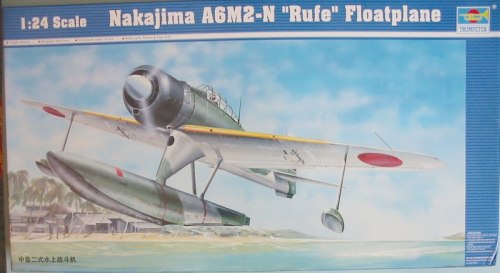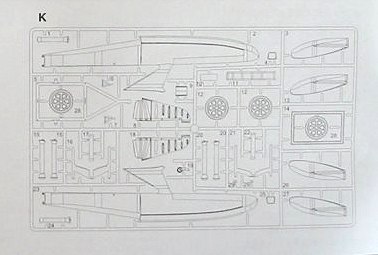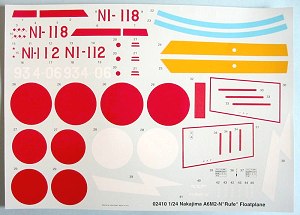
|
KIT: |
Trumpeter 1/24 A6M2-N 'Rufe' |
|
KIT # |
? |
|
PRICE: |
$129.95 MSRP |
|
DECALS: |
3 options |
|
REVIEWER: |
Tom Cleaver |
|
NOTES: |

|
HISTORY |
Masatake Okumiya, former IJN staff officer and historian of the Japanese Navy in the Pacific War, stated in his book, "Zero," that the single thing he found most amazing during the war was the ability of the Americans to construct airfields as fast as they did after capturing an island. He contrasted this with the inability of the Japanese to ever completely finish the field at Buin, in the Solomons, despite having nearly six months to accomplish this. This was undoubtedly due to the fact that the Japanese had no history of massive, fast‑paced construction projects using the latest technology, which had been the American way of going about things for close to a century prior to the Pacific War, and consequently did not have heavy construction equipment in the numbers necessary to accomplish the early construction of such vital installations. It was this difference that led to the deployment of the only successful floatplane fighter used by any combatant in the Second World War.
The IJN knew it had a world‑beater in the Mitsubishi A6M "Zero" by September 1940, when one squadron of Zeros completely routed what remained of Chinese air power over the mainland.
Planning was already afoot for what would become The Pacific War; one problem planners faced was how to provide air cover for an island invasion force once ashore, before they could construct an airfield. The carriers could not remain offshore, tied to the battle on the island and thereby making targets of themselves for enemy air forces. The decision was made to develop a floatplane capable of meeting and defeating enemy aircraft during the period between invasion and deployment of land-based aircraft. This led to the 15‑Shi Float Fighter Kyofu (N1K1) from Kawanishi. As the project fell behind schedule, a decision was made to create a floatplane fighter based on the A6M2 Zero. Nakajima, which was already involved in Zero production, was given the assignment.
The first A6M‑2N flew on the day of the attack on Pearl Harbor, and was so successful it was ordered into immediate production as the 2‑Shi (Type 2) Float Fighter A6M2-N. While the central float with two outboard floats resulted in a severe degradation in maximum speed, from 335 mph to 275 mph, maneuverability was only slightly degraded from the land‑based fighter.
Navy fliers from the “Yorktown” reported combat with the “Rufe” during the Tulagi raid of May 5, 1942, but in fact the A6M2-N, given the Allied reporting name of "Rufe," first appeared on operations shortly after the invasion of the Aleutians on June 8, 1942 ‑ the first combat between A6M‑2Ns and American forces being an interception of a B‑24 on July 5, 1942. On July 11, three B‑17s and seven B‑24s were intercepted, the Japanese claiming one B‑24 damaged, though in fact they destroyed a B‑17. From August 1942 to March 1943, a fairly vicious air war developed between the Rufes and Allied aircraft based at Dutch Harbor. Naval Air Pilot 2/c Yoshiichi Sasaki emerged as the highest‑scoring Japanese pilot of this campaign, with four individual kills and five assists.
The first A6M‑2Ns arrived at Rabaul on June 3, 1942, and had moved on to Tulagi in the Solomon Islands by early July; battles were fought with high‑flying American B‑17s and B‑24s, with a B‑24 claimed shot down on July 10, 1942. On August 7, 1942, the unit's aircraft were destroyed in a strafing attack by U.S. Navy F4Fs and SBDs during the American invasion of Guadalcanal.
With Rabaul being the closest Japanese airfield, a seaplane base was established in the Shortland Islands south of Bougainville, with an advance base at Rekata Bay on the east coast of Santa Isabel Island, 95 miles from Guadalcanal. Rufes began operations over Guadalcanal from these bases on September 4, 1942. Their first victory was an SBD caught as it was about
to land at Henderson Field on September 13. From then on, the Rufes would be engaged in anti‑PT boat patrols and escorts for the ships of the Tokyo Express as they made their way down "The Slot" in increasingly‑desperate attempts to resupply the Japanese forces on Guadalcanal. Marine and Navy fighter pilots soon discovered what their USAAF comrades had found out in the Aleutians: the ungainly‑looking Rufe was a difficult target and a dangerous opponent, though they would always be able to get away from the airplane by using their superior diving ability and higher speed to escape when necessary.
The Rufe's combat operations in the Solomons ended in March 1943, when the unit was sent to Jaluit in the Marshall Islands; they moved on to Truk that fall, and met the USN again on February 7, 1944, when the fast carriers struck the Japanese Navy's main central Pacific base. A6M‑2Ns remained at Truk until the Fall of 1944, flying against B‑25 and B‑24 raids mounted by the 7th Air Force.
In the Netherlands East Indies, A6M‑2Ns of the 934th Air Group arrived in the Spring of 1943, and fought Australian Beaufighter and B‑25 raids until the fall of 1944. Japanese Chief
Petty Officer Eitoku Matsunaga became the top floatplane ace of the war during this period, scoring 8 individual kills against the RAAF. Final use of the Rufe was over the home islands, where they scored two kills against Hellcats during the Tokyo Strikes on February 7, 1945; the remaining floatplane fighters were destroyed that spring in American raids on their base.
|
THE KIT |

Trumpeter has single-handedly revived the 1/24 scale plastic model airplane market with their releases in the past year of the P-51D Mustang, A6M2 Zero, Spitfire V and Bf-109G-6. Unfortunately, only the Bf-109G-6 kit is a fully accurate rendition of the original that displays what is possible with a kit in this scale.
The Zero kit
suffered from an incorrect fuselage, which in profile had the cockpit
area raised too high, resulting in a very strange-looking model when
completed. Sadly, this A6M2-N “Rufe” suffers from the same mistake. I
say sad because otherwise, this is a beautifully-molded kit, with lots of
detail in nearly 400 parts, that will make up into an impressive model
which - despite all the efforts of the modeler short of reconstructing
the fuselage and scratchbuilding a new canopy - will still
 be wrong in the
end. (Editor's Note: I've only shown the drawing of the one sprue
different from the land-based version. Showing drawings of all of the
sprues seems redundant. The kit is molded just like every other big scale
Trumpeter kit. If you want to see more detail on what is awry with this
kit, visit www.j-aircraft.com )
be wrong in the
end. (Editor's Note: I've only shown the drawing of the one sprue
different from the land-based version. Showing drawings of all of the
sprues seems redundant. The kit is molded just like every other big scale
Trumpeter kit. If you want to see more detail on what is awry with this
kit, visit www.j-aircraft.com )
The main difference between this kit and the original Zero release is the redesign of the rear fuselage for the different rudder of this sub-type, and a lower wing without gear wells. New sprues include the main float in two pieces and the stabilizing floats.
Decals are provided for three Rufes, one in overall grey, and the others with differing patterns of dark green oversprayed on the upper surfaces.
|
CONCLUSIONS |
This will make up into an impressive model. Unfortunately, at a cost of over $100, it is this reviewer’s contention that the least that could be expected is outline accuracy. Anything else can be fixed with an application of “some modeling skill required,” but fixing this is going to take major surgery. It’s too bad Trumpeter didn’t take the opportunity with this release to get the Zero “right,” the way they did with the Grumman Wildcat kit. I am quite frustrated, since - other than the fuselage and engine cowling - the rest of the kit is well made and looks accurate, but the fuselage and cowling are just too prominent for me to be able to ignore the result. Better luck next time.
Review Kit Courtesy of Stevens International
If you would like your product reviewed fairly and quickly by a site that has nearly 250,000 visitors a month, please contact me or see other details in the Note to Contributors.